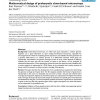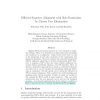186 search results - page 20 / 38 » A new approach to fragment assembly in DNA sequencing |
BMCBI
2005
13 years 7 months ago
2005
Background: Clone-based microarrays, on which each spot represents a random genomic fragment, are a good alternative to open reading frame-based microarrays, especially for microo...
GECCO
2004
Springer
14 years 22 days ago
2004
Springer
Understanding the hierarchical relationships among biochemical, metabolic, and physiological systems in the mapping between genotype and phenotype is expected to improve the diagno...
IMSCCS
2006
IEEE
14 years 1 months ago
2006
IEEE
Background: The amplification of variable regions of immunoglobulins has become a major challenge in the cloning of antibody genes, whether from hybridoma cell lines or splenic B ...
CONSTRAINTS
2008
13 years 7 months ago
2008
Aligning DNA and protein sequences is a core technique in molecular biology. Often, it is desirable to include partial prior knowledge and conditions in an alignment. Going beyond...
BMCBI
2011
12 years 11 months ago
2011
Background: With next-generation sequencing technologies, experiments that were considered prohibitive only a few years ago are now possible. However, while these technologies hav...


